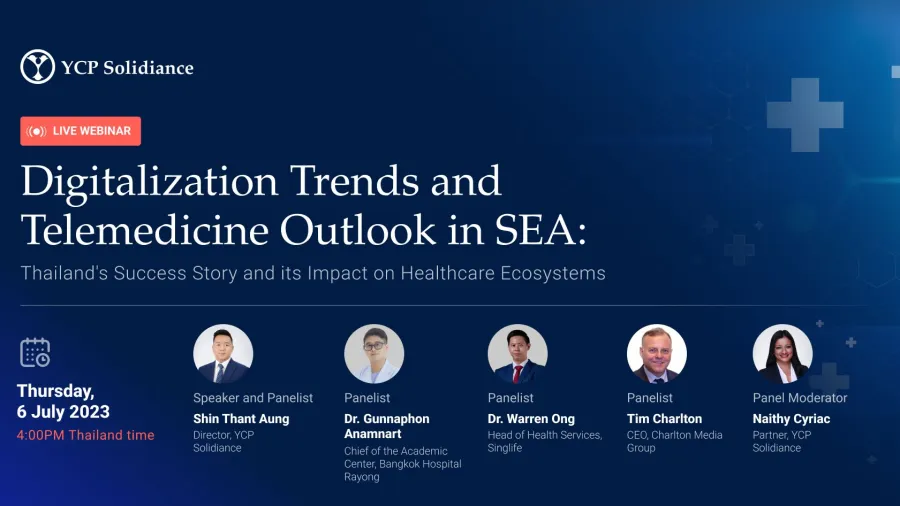
Evolving telemedicine encounters changing regulations, language barrier in Thailand
Healthcare providers need to adapt to new rules and changing consumer preferences for telemedicine.
As the healthcare sector embraced telemedicine, experts warn that healthcare providers may still need to address bottlenecks such as laws and fulfilling new consumer demands.
Whilst telemedicine is widely used in Thailand, YCP Solidiance Director Shin Thant Aung said one of the challenges in the implementation is the continued changes in health regulations.
“If regulations keep changing these technologies that we utilise, how can hospitals deliver further results? So it’s very important for us to understand how the regulations are changing for the government. We might need to look at the long-term picture rather than changing on a very short term,” Aung told YCP Solidiance Partner Naithy Cyriac during the panel discussion at YCP Solidiance’s live webinar about telemedicine trends in Southeast Asia.
Dr. Warren Ong, head of health services at Singlife, said they are having issues with language barriers as people of the older generation in Singapore use dialects.
Dr. Gunnaphon Anamnart, chief of the Academic Center at Bangkok Hospital Rayong, said infrastructure is also a problem such as creating a unified database.
“The barrier is the seamless service because there are many competitors in Thailand; everyone wants to view their own database or application,” said Anamnart.
Also, internet connection remains a hurdle for conducting teleconsultations because the connection is still unsteady in crowded or big cities despite the 5G network in Thailand, Anamnart said.
Data privacy needs to be dealt with
Meanwhile, Aung cited that there is limited patient awareness and education as concerns for data and security are increasing with the Personal Data Protection Act (PDPA).
For telemedicine, specifically, Aung said there is a lot more to explore in upgrading the healthcare model. Normally, telemedicine 1.0 uses video conferencing to conduct consultations at home but shifting to telemedicine 2.0 may use more advanced tech such as Apple Watch and Fitbit for suitable data regarding health and fitness.
On data privacy, Timothy Charlton, editor-in-chief of Charlton Media Group, asserted that data privacy concerns in telemedicine are still an issue that can be dealt with. He cited that even in Singapore there are cyberthreats getting hold of data.
“A lot more needs to be done with regard to telemedicine. How strong is encryption? We always think of security about how secure the database is with the patient. How secure are the communication lines? This isn’t going to be a huge barrier, but it’s something that has to be looked at,” said Charlton, who has led Healthcare Asia forums.
Another challenge faced by digital healthcare providers in Thailand is the resistance of healthcare staff to using cutting-edge technology due to a lack of training and education.
“Digital health technology will be a normal way of working in a hospital because [the healthcare facility] needs to upgrade to new technology so education is required,” said Aung.
For his part, Anamnart said Bangkok Hospital Rayong has Generation X staff who cannot learn new and complicated tech tools.
Telemedicine is still necessary
Telemedicine may have lower utilisation during the post-pandemic era compared to pandemic levels, but is still relevant to hospitals in Southeast Asia.
Aung said the elderly population in Thailand is growing due to a longer life expectancy and improved healthcare delivery. He mentioned that the ageing population will be helped if Thailand would only step up telemedicine.
“They need telemedicine because, for older people, it is more difficult to go to the hospital than the younger generation,” he said.
The key causes of death in Thailand are cancerous tumors, circulatory system diseases, and respiratory ailments, which are very common for the geriatric population.
At the Bangkok Hospital Rayong, Anamnart said telemedicine has significantly reduced patients’ waiting time and secured on-time appointments.
Ong said healthcare providers in Singapore are looking at innovative programmes to augment the capabilities of telemedicine such as virtual hospitals implementing homecare, AI tools, and remote diagnostics.
He added that telemedicine in the city-state is being approved for chronic disease management, and the new healthcare reform, HealthierSG, moves to make a mainstream approach to telemedicine.
For Charlton, healthcare providers need to improve their digital game as consumers, nowadays, want to have healthcare access in a single touchpoint. He cited as examples telehealth and online booking app.
“Whether it’s a hospital group with an app for booking, telemedicine, delivery of all of the drug products to you, all that sort of stuff is vitally important,” Charlton told his fellow panellists.



















 Advertise
Advertise






